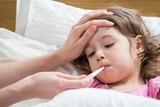What is a fever?
A fever is formally defined by most primary care providers as a temperature of 100.4 degrees Fahrenheit (38 degrees Celsius) and higher.
What happens when your child gets a fever?
Your child makes a fever to fight off germs. Your child’s immune system increases the body temperature to help your child get rid of germs without causing harm to your child.
A fever often makes your child feel hot and look flushed. Fevers can cause headaches or body aches, sweating or shivering. Some kids get headaches with fever, and most kids lose their appetites with fever. Some kids just feel sleepier than usual. Many kids are cranky when they have fevers and feel much better when their fevers go down again.
You may notice your child’s heart rate and breathing rate increase with fever, similar to if they were just running. This is a normal part of fever.
What conditions can cause a fever?
Fevers are common in children. Most fevers in children are caused by viruses. A much smaller number are due to bacterial infections, such as ear infections, strep throat or pneumonia.
Prolonged fever, meaning fever for more than a week, or recurring fevers can be a sign of underlying chronic disease, so it is important to check with your child's primary care provider.
When should a fever be treated?
A fever should be treated when it causes discomfort to your child. Treating fever can relieve associated aches and pains, allowing your child to sleep more comfortably and to drink well to prevent dehydration. If your child is already sleeping well with fever and is comfortable while awake, you do not need to treat the fever. Treating your child's fever will not help the body get rid of the infection any faster; it simply will relieve discomfort associated with fever.
What can I do to decrease my child's fever?
If a fever is making your child uncomfortable, administer an anti-fever medication, such as acetaminophen or ibuprofen. DO NOT give your child aspirin, as it has been linked to a serious, potentially fatal disease, called Reye syndrome.
Other ways to help your child feel more comfortable when they have a fever:
- Dress your child lightly. Excess clothing will trap body heat and cause the temperature to rise. However, if your child feels cold, let them have their extra blanket. The goal is comfort, not “getting the fever down.”
- Encourage your child to drink plenty of fluids, such as juices, milk, sports drinks, soup broth or popsicles.
- Give your child a lukewarm bath if they find this comforting. Do not allow your child to shiver from cold water, as this can raise the body temperature. NEVER leave your child unattended in the bathtub.
- Place cold washcloths over areas of the body where the blood vessels are close to the surface of the skin such as the forehead, wrists and groins.
- DO NOT use alcohol baths.
When should I call my child's primary care provider?
If your child is younger than 2 months with a rectal temperature greater than 100.4 degrees Fahrenheit (38 degrees Celsius), go to an emergency department immediately.
If your child is between 2 and 3 months old and their temperature (taken any way) is greater than 100.4 degrees Fahrenheit, call your baby’s primary care provider immediately.
If your child is older than 3 months, call the primary care provider right away if:
- Your child is crying inconsolably.
- Your child is difficult to awaken.
- Your child has been in a very hot place, such as inside a hot car.
- Your child has other symptoms such as a severe headache, stiff neck, or other severe pain.
- Fever is accompanied by a rash.
- Your child is taking steroids or has an immune system problem, such as cancer.
- Your child looks or acts very sick.
- Your child has severe vomiting or diarrhea.
- Your child is not up to date on their vaccines.
- Your child has a seizure (convulsion).
Call your child's primary care provider if any of the following conditions are present:
- Your child has a fever for more than two or three days.
- Your child seems to be getting worse or still acts sick when the fever comes down.
- You have other concerns or questions.
I have heard of children having a seizure from fever. What should I do about that?
About 3% of children between the ages of 6 months and 5 years can develop seizures from fever, called febrile seizures. There is a tendency for this to occur if a family member also had febrile seizures as a child. The seizures involve total body shaking and typically last fewer than two minutes.
If your child does have a febrile seizure, place them on the floor where they cannot fall, and where you can extend their airway. If you hold them and their neck is flexed, they might have difficulty breathing. If your child has a febrile seizure, call their primary care provider or seek medical attention.
Febrile seizures do not typically cause any damage to children. A febrile seizure does not mean your child has epilepsy. Treating a fever does not typically reduce the risk of having a febrile seizure, especially since most febrile seizures occur at the onset of fever, before you realize that your child is sick.

Fever: A review of what to do
Pediatricians want you to know this: Nothing has changed about how you should manage a fever.
Reviewed by Julie Kardos, MD, FAAP, Naline Lai, MD, FAAP